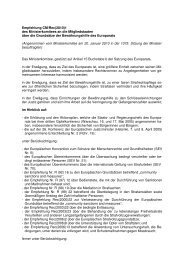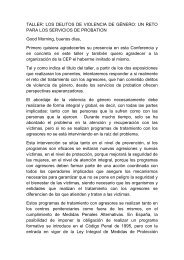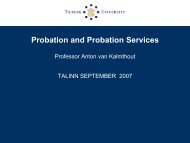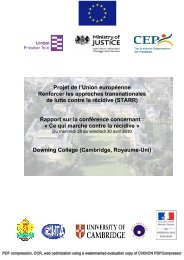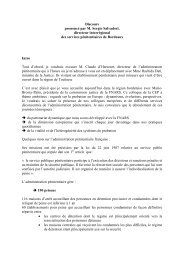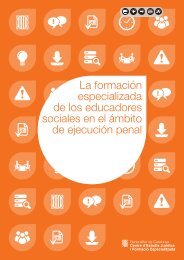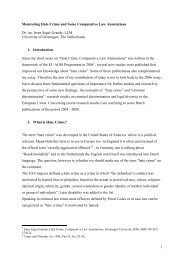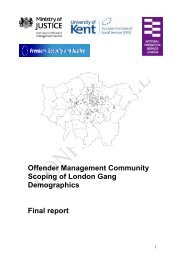Assessing delinquent attributions and planning interventions
Assessing delinquent attributions and planning interventions
Assessing delinquent attributions and planning interventions
Create successful ePaper yourself
Turn your PDF publications into a flip-book with our unique Google optimized e-Paper software.
<strong>Assessing</strong> <strong>delinquent</strong><br />
<strong>attributions</strong> <strong>and</strong> <strong>planning</strong><br />
<strong>interventions</strong><br />
Neven Ricijaš, Ph.D.<br />
Department of Behavioural Disorders<br />
Faculty of Education <strong>and</strong> Rehabilitation Sciences<br />
University of Zagreb
Why do juveniles commit<br />
criminal offences?<br />
What are the reasons for their<br />
<strong>delinquent</strong> behaviour?
Risk/Need Factors: The Central Eight<br />
(Andrews & Bonta, 2006)<br />
1. History of Antisocial Behaviour<br />
2. Antisocial Personality Pattern<br />
3. Antisocial Cognition<br />
4. Antisocial Associates<br />
5. Family/Marital Circumstances<br />
6. School/Work<br />
7. Leisure/Recreation<br />
8. Substance Abuse
What do juveniles think, why do<br />
they commit criminal offences?<br />
How do they attribute their<br />
<strong>delinquent</strong> behaviour?<br />
Is it important how the attribute<br />
their <strong>delinquent</strong> behaviour?
Delinquent Attribution Scale<br />
DAS-J<br />
(version for Juveniles)<br />
- Steps in scale construction -
1st step – Defining theoretical background<br />
Weiner’s<br />
attribution<br />
theory<br />
Criminogenic<br />
risk/need<br />
approach
Weiner’s attribution theory<br />
• Weiner developed a theoretical framework that has<br />
become very influential in social psychology today.<br />
• Attribution theory assumes that people try to<br />
determine why people do what they do, that is,<br />
interpret causes to an event or behavior.<br />
• A three-stage process underlies an attribution:<br />
<br />
<br />
<br />
behavior must be observed/perceived<br />
behavior must be determined to be intentional<br />
behavior attributed to internal or external causes
Weiner’s attribution theory<br />
• Attributions are classified along three causal<br />
dimensions:<br />
1. locus of control (two poles: internal vs. external)<br />
2. stability (do causes change over time or not?)<br />
3. controllability (causes one can control such as<br />
skills vs. causes one cannot control such as luck,<br />
others’ actions, etc.)
Weiner’s attribution theory<br />
INTERNAL<br />
EXTERNAL<br />
STABLE UNSTABLE STABLE UNSTABILE<br />
HAS NO<br />
CONTROL<br />
HAS<br />
CONTROL
Integration of Weiner’s attribution theory<br />
with Criminogenic Risk/Need Theory<br />
INTERNAL<br />
EXTERNAL<br />
STABLE UNSTABLE STABLE UNSTABLE<br />
HAS NO<br />
CONTROL<br />
Poor selfcontrol<br />
Impulsive<br />
attack<br />
Poor family<br />
relationship<br />
Drunkenness<br />
HAS<br />
CONTROL<br />
Need for<br />
taking risks<br />
Boredom<br />
Earnings<br />
Current<br />
financial<br />
gains
2nd step – Generating item pool<br />
1. Defining categories (7 internal <strong>and</strong> 7 external<br />
categories)<br />
2. Personal ideas (generating items)<br />
3. Three focus groups with juvenile <strong>delinquent</strong>s in<br />
correctional institution<br />
a) Generating items<br />
b) Checking all 156 items<br />
Preliminary version of the Scale has 140 items.<br />
(1 = completely untrue; 5 = completely true)
3rd step – Conducting pilot research<br />
N = 108 juvenile <strong>delinquent</strong>s<br />
in the city of Zagreb<br />
a) On probation<br />
b) In open residential facility<br />
c) In closed correctional institution<br />
Mage = 17,28 SDage = 1,622<br />
(Min. 14 - Max. 21)
4th step – Item reduction steps<br />
1. Poor distribution<br />
2. Factor structure of each category<br />
3. Inter-item <strong>and</strong> item-total correlations<br />
4. Factor structure of the whole internal <strong>and</strong><br />
external domain
Final Research <strong>and</strong> Results
Sample<br />
• N=335 male juvenile <strong>delinquent</strong>s in the<br />
Republic of Croatia<br />
• 56,1% institutional treatment<br />
• 43,9% on probation<br />
• Mage = 17,1 (SDage = 1,85)<br />
• Minage = 14 Maxage = 21
Delinquent Attribution Scale<br />
• final version has 60 items<br />
• two subscales:<br />
<br />
<br />
internal (4 factors = 24 items)<br />
external (8 factors = 36 itmes)
Delinquent Attribution Scale<br />
Factors<br />
No.<br />
Items<br />
%<br />
variance<br />
α -<br />
Cronbach<br />
Internal subscale 24 57,82 ,906<br />
1. Antisocial tendencies*** 12 25,98 ,913<br />
2. Susceptibility to peers 4 11,12 ,813<br />
3. Thoughtlessness 4 10,65 ,733<br />
4. Personal frustration 4 10,12 ,770<br />
*** this factor consists of three areas: (1) <strong>delinquent</strong> identity, (2) antisocial<br />
attitudes, (3) fun <strong>and</strong> excitement
Delinquent Attribution Scale<br />
Factors<br />
No.<br />
Items<br />
%<br />
variance<br />
α -<br />
Cronbach<br />
External subscale 36 68,96 ,923<br />
1. Poverty <strong>and</strong> material gain 8 12,83 ,901<br />
2. Poor family relationships 4 10,64 ,811<br />
3. Drugs 4 9,41 ,911<br />
4. Alcohol 4 9,36 ,908<br />
5. Antisocial peers 4 7,60 ,811<br />
6. Permissive parents 4 7,15 ,786<br />
7. Situation 4 6,03 ,705<br />
8. Over-controlling parents 4 5,94 ,802
Differences in <strong>delinquent</strong> <strong>attributions</strong> regarding the<br />
frequency of <strong>delinquent</strong> behaviour (ANOVA)<br />
4<br />
3,5<br />
3<br />
2,5<br />
** **<br />
**<br />
** **<br />
**<br />
** **<br />
**<br />
2<br />
1,5<br />
1<br />
ANTISOCIAL TENDENCIES<br />
PERSONAL FRUSTRATION<br />
SUSCEPTIBILITY TO PEERS<br />
THOUGHTLESSNESS<br />
POVERTY<br />
POOR FAMILY RELATIONSHIPS<br />
DRUGS<br />
ALCOHOL<br />
ANTISOCIAL PEERS<br />
PERMISIVE PARENTS<br />
SITUATIONS<br />
OVER-CONTROLLING PARENTS<br />
RARELY OFTEN VERY OFTEN
Differences in <strong>delinquent</strong> <strong>attributions</strong> regarding the lenght<br />
of <strong>delinquent</strong> behaviour (ANOVA)<br />
4<br />
3,5<br />
3<br />
2,5<br />
** **<br />
**<br />
**<br />
**<br />
**<br />
**<br />
*<br />
2<br />
1,5<br />
1<br />
ANTISOCIAL TENDENCIES<br />
PERSONAL FRUSTRATION<br />
SUSCEPTIBILITY TO PEERS<br />
THOUGHTLESSNESS<br />
POVERTY<br />
POOR FAMILY RELATIONSHIPS<br />
DRUGS<br />
ALCOHOL<br />
ANTISOCIAL PEERS<br />
PERMISIVE PARENTS<br />
SITUATIONS<br />
OVER-CONTROLLING PARENTS<br />
1 YEAR 2 YEARS 3 YEARS 4 OR MORE YEARS
Differences in <strong>delinquent</strong> <strong>attributions</strong> regarding the<br />
beginning of <strong>delinquent</strong> behaviour (t-test)<br />
4<br />
3,5<br />
3<br />
2,5<br />
2<br />
**<br />
**<br />
**<br />
*<br />
**<br />
**<br />
**<br />
*<br />
1,5<br />
1<br />
ANTISOCIAL TENDENCIES<br />
PERSONAL FRUSTRATION<br />
SUSCEPTIBILITY TO PEERS<br />
THOUGHTLESSNESS<br />
POVERTY<br />
POOR FAMILY RELATIONSHIPS<br />
DRUGS<br />
ALCOHOL<br />
ANTISOCIAL PEERS<br />
PERMISIVE PARENTS<br />
SITUATIONS<br />
OVER-CONTROLLING PARENTS<br />
EARLY-STARTERS<br />
LATE-STARTERS
Differences between low-risk <strong>and</strong> high-risk <strong>delinquent</strong>s<br />
LOW-RISK<br />
HIGH-RISK<br />
ANTISOCIAL<br />
TENDENCIES<br />
THOUGHTLESSNESS<br />
SITUATON<br />
PERSONAL<br />
FRUSTRATION<br />
ANTISOCIAL PEERS<br />
POVERTY AND<br />
MATERIAL GAIN<br />
DRUGS<br />
ALCOHOL
LEVEL OF RISK<br />
DELINQUENT ATTRIBUTIONS<br />
HIGH-RISK<br />
Commit various criminal offences,<br />
from small delicts to serious<br />
criminal acts (a lot of risk<br />
behaviour, property <strong>and</strong> violence<br />
offences <strong>and</strong> drug offences).<br />
MODERATE-RISK<br />
Commit small delicts, different risk<br />
behaviours <strong>and</strong> property offences.<br />
LOW-RISK<br />
Commit only small delicts <strong>and</strong> risk<br />
behaviour.<br />
1. Drugs<br />
2. Antisocial tendencies<br />
3. Poverty <strong>and</strong> material gain<br />
4. Antisocial peers<br />
5. Alcohol<br />
6. Personal frustration<br />
1. Thoughtlessness<br />
2. Antisocial tendencies<br />
3. Antisocial peers<br />
4. Personal frustration<br />
5. Situation<br />
1. Poor family relationships<br />
2. Alcohol<br />
3. Situation
1.0 1.0 1.0 1.0 1.0 1.0<br />
Mean<br />
Antisocial<br />
tendencies<br />
Personal<br />
frustration<br />
Susceptibility<br />
to peers<br />
Thoughtlessness<br />
Poverty <strong>and</strong><br />
meterial gain<br />
Antisocial<br />
peers<br />
5<br />
5.0<br />
.<br />
.<br />
5.0<br />
.<br />
.<br />
5.0<br />
.<br />
.<br />
5.0<br />
.<br />
.<br />
5.0<br />
.<br />
.<br />
5.0<br />
.<br />
.<br />
4<br />
4.0<br />
.<br />
.<br />
4.0<br />
.<br />
.<br />
4.0<br />
.<br />
.<br />
4.0<br />
.<br />
.<br />
4.0<br />
.<br />
.<br />
4.0<br />
.<br />
.<br />
3<br />
3.0<br />
.<br />
.<br />
3.0<br />
.<br />
.<br />
3.0<br />
.<br />
.<br />
3.0<br />
.<br />
.<br />
3.0<br />
.<br />
.<br />
3.0<br />
.<br />
.<br />
2<br />
2.0<br />
.<br />
.<br />
2.0<br />
.<br />
.<br />
2.0<br />
.<br />
.<br />
2.0<br />
.<br />
.<br />
2.0<br />
.<br />
.<br />
2.0<br />
.<br />
.<br />
1 1.0 1.0 1.0 1.0 1.0 1.0<br />
Mean Drugs Alcohol<br />
Poor family<br />
relationships<br />
Permisive<br />
parents<br />
Overcontrolling<br />
p.<br />
Situation<br />
5<br />
5.0<br />
.<br />
.<br />
5.0<br />
.<br />
.<br />
5.0<br />
.<br />
.<br />
5.0<br />
.<br />
.<br />
5.0<br />
.<br />
.<br />
5.0<br />
.<br />
.<br />
4<br />
4.0<br />
.<br />
.<br />
4.0<br />
.<br />
.<br />
4.0<br />
.<br />
.<br />
4.0<br />
.<br />
.<br />
4.0<br />
.<br />
.<br />
4.0<br />
.<br />
.<br />
3<br />
3.0<br />
.<br />
.<br />
3.0<br />
.<br />
.<br />
3.0<br />
.<br />
.<br />
3.0<br />
.<br />
.<br />
3.0<br />
.<br />
.<br />
3.0<br />
.<br />
.<br />
2<br />
2.0<br />
.<br />
.<br />
2.0<br />
.<br />
.<br />
2.0<br />
.<br />
.<br />
2.0<br />
.<br />
.<br />
2.0<br />
.<br />
.<br />
2.0<br />
.<br />
.
Implications for <strong>planning</strong> <strong>interventions</strong><br />
DAS aims to assess the perspective of juvenile<br />
<strong>delinquent</strong>s regarding the reasons for their <strong>delinquent</strong><br />
behaviour<br />
it focuses on dynamic risk factors<br />
the structure of <strong>attributions</strong> can differentiate various types<br />
of juvenile <strong>delinquent</strong>s (low/high risk)<br />
it could be a useful tool to gain additional information<br />
about the status of a juvenile <strong>and</strong> his cognitive believes,<br />
which has implications in <strong>planning</strong> <strong>interventions</strong> as well as<br />
in expected outcomes
Thank you for your attention!




![AGIS2 Nov 08 Conference Report_[Version 2] - CEP, the European ...](https://img.yumpu.com/50764570/1/190x245/agis2-nov-08-conference-report-version-2-cep-the-european-.jpg?quality=85)
